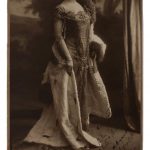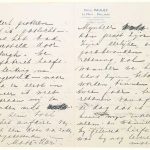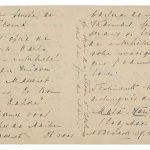Margaretha Geertruida “Margreet” MacLeod (née Zelle; 7 August 1876 – 15 October 1917), better known by the stage name Mata Hari , was a Dutch exotic dancer and courtesan who was convicted of being a spy for Germany during World War I and executed by firing squad in France. Reference: Mata Hari: The True Story Promiscuous, flirtatious, and openly flaunting her body, Mata Hari captivated her audiences and was an overnight success from the debut of her act at the Musée Guimet on 13 March 1905. She became the long-time mistress of the millionaire Lyon industrialist Émile Étienne Guimet, who had founded the Musée. She posed as a Javanese princess of priestly Hindu birth, pretending to have been immersed in the art of sacred Indian dance since childhood. She was photographed numerous times during this period, nude or nearly so. Some of these pictures were obtained by MacLeod and strengthened his case in keeping custody of their daughter.During World War I, the Netherlands remained neutral. As a Dutch subject, Zelle was thus able to cross national borders freely. To avoid the battlefields, she travelled between France and the Netherlands via Spain and Britain, and her movements inevitably attracted attention.
In November 1916, she was travelling by steamer from Spain when her ship called at the British port of Falmouth. There she was arrested and brought to London where she was interrogated at length by Sir Basil Thomson, assistant commissioner at New Scotland Yard in charge of counter-espionage.
Zelle was executed by a firing squad of 12 French soldiers just before dawn on 15 October 1917. She was 41. According to an eyewitness account by British reporter Henry Wales, she was not bound and refused a blindfold. Reference: Wikipedia
MATA HARI pseud. Margaretha Grietje Zelle. 1876-1917.
Dancer and courtesan, shot for spying. Photography portrait, signed and autographed. Monte Carlo, April 10th, 1906. Silver print on the photograph’s cardboard (Berlin, Atelier Ernst Schneider), large format, sent and autographed with black ink on the lower corner. Beautiful portrait of the famous courtesan during her journey in Monaco sent to a friend, thanking her for her precious care.
Sold for €2,700 at Hermitage Fine Art in 2019
Mata Hari (Margaretha Geertruida Zelle) Autograph letter in Dutch, signed (“Mata Hari”), The Hague, 8 August 1915, 8 pages on Hotel Paulez stationery (8 1/2 x 5 1/2 in.; 220 x 140 mm), to her attorney Mr. E. Eijmans, complaining about problems with the contractor who is working on furnishing her house and the costly delays; one cellophane repair to a short marginal tear. Together with: a transcription of the letter.Quarter red morocco folding case.
Mata Hari complains angrily to her lawyer about the costly delays in furbishing her house in The Hague and in her fury lashes out at the contractor: I am enclosing a bill from the carpenter, intended for Mr. Soet, but sent to me. I am sorry these people come bothering me with it at the Hotel Paulez. … If Mr. Soet does not want to keep his word, I would rather he took everything he brought into the house out again. His extra cost is perhaps 400 guilders, but mine is 4,000. I have the receipts from the Hotel Victoria and Hotel Paulez to show him. … His honest and approved bill will be paid if he keeps his word—paid within two years from the day I move into the house, and when he has delivered all he still has to deliver.”
She admits some progress has been made (a gas meter repaired, a bathtub installed) but stubbornly insists: “I reserve the right to sue for damages and for his insulting me in Wurfbain’s office, and for the dirty work with the bill and for the long sojurn in hotels … Please do point out to him how unfair it is to do business this way.”
Sold for 4,063 USD at Sotheby’s in 2013
HARI, MATA (MARGARETHA GERTRUIDA ZELLE MACLEOD). 1876-1917. Autograph Letter Signed (“Mata Hari (Lady MacLeod)”), 4 pp recto and verso, 8vo (conjoining leaves), Rome, March 20, n.y. [but c.1906], to Mr. Strauss, on Hotel Bristol stationery, light toning, otherwise very fine. Although remembered for her arrest and execution as a German spy during World War I, Mata Hari was at the turn of the century one of Europe’s most popular performers and an important innovator of modern dance along with Isadora Duncan and Ruth St. Denis. She writes this letter to Richard Strauss regarding his opera Salome. Translated: “I read in the newspapers that your opera ‘Salome,’ will be performed on the 10th May in Paris. As soon as I return to Berlin I ask you to see me. I desire to create ‘the dance’ and above all to dance the role in Paris, where I am so very well known and am the only one who can dance the inner thoughts of Salome! … I will be so happy to interpret your music that I admire so much.”
Sold for US$ 6,100 (£ 4,897) inc. premium at Bonham’s in 2011





